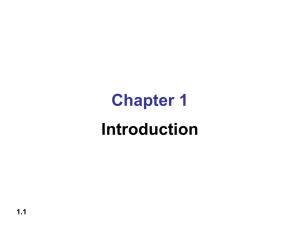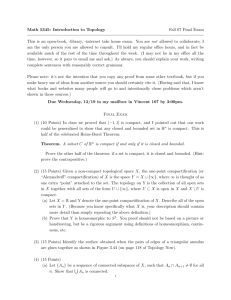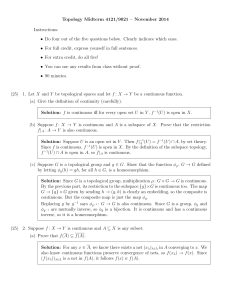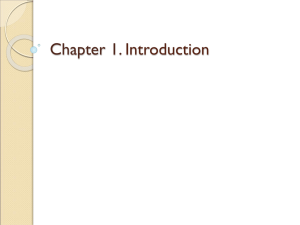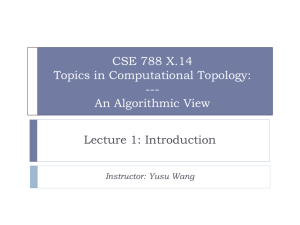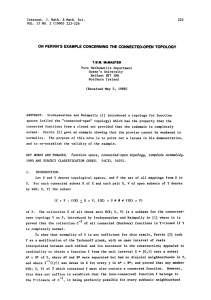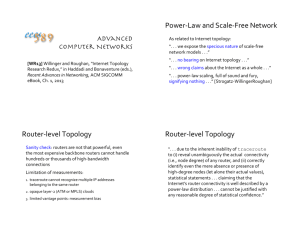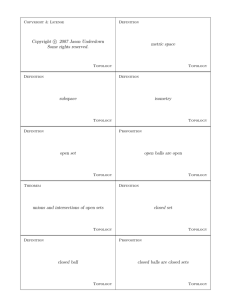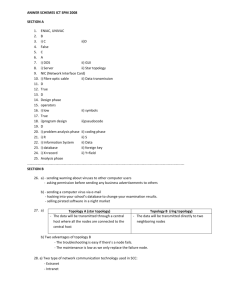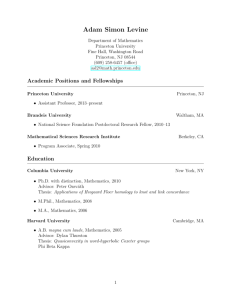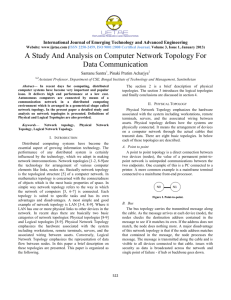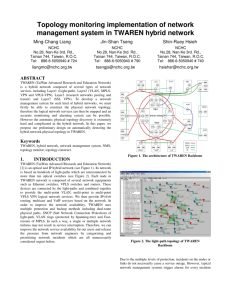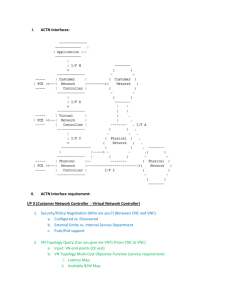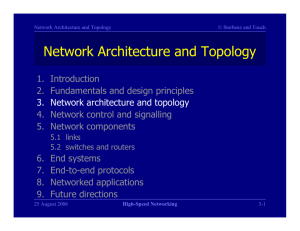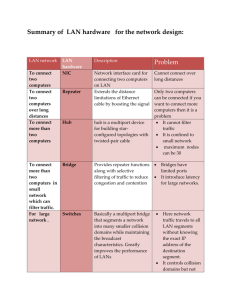MATH 3402 Tutorial sheet 5 Solutions 1. If f is a many
advertisement
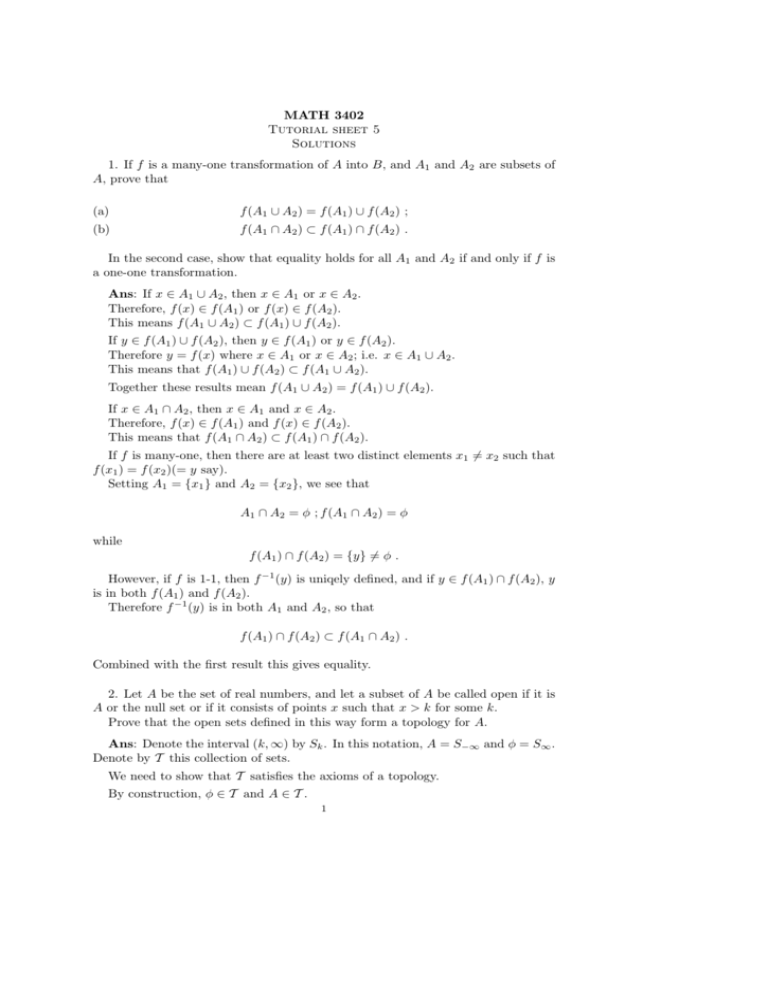
MATH 3402
Tutorial sheet 5
Solutions
1. If f is a many-one transformation of A into B, and A1 and A2 are subsets of
A, prove that
(a)
f (A1 ∪ A2 ) = f (A1 ) ∪ f (A2 ) ;
(b)
f (A1 ∩ A2 ) ⊂ f (A1 ) ∩ f (A2 ) .
In the second case, show that equality holds for all A1 and A2 if and only if f is
a one-one transformation.
Ans: If x ∈ A1 ∪ A2 , then x ∈ A1 or x ∈ A2 .
Therefore, f (x) ∈ f (A1 ) or f (x) ∈ f (A2 ).
This means f (A1 ∪ A2 ) ⊂ f (A1 ) ∪ f (A2 ).
If y ∈ f (A1 ) ∪ f (A2 ), then y ∈ f (A1 ) or y ∈ f (A2 ).
Therefore y = f (x) where x ∈ A1 or x ∈ A2 ; i.e. x ∈ A1 ∪ A2 .
This means that f (A1 ) ∪ f (A2 ) ⊂ f (A1 ∪ A2 ).
Together these results mean f (A1 ∪ A2 ) = f (A1 ) ∪ f (A2 ).
If x ∈ A1 ∩ A2 , then x ∈ A1 and x ∈ A2 .
Therefore, f (x) ∈ f (A1 ) and f (x) ∈ f (A2 ).
This means that f (A1 ∩ A2 ) ⊂ f (A1 ) ∩ f (A2 ).
If f is many-one, then there are at least two distinct elements x1 6= x2 such that
f (x1 ) = f (x2 )(= y say).
Setting A1 = {x1 } and A2 = {x2 }, we see that
A1 ∩ A2 = φ ; f (A1 ∩ A2 ) = φ
while
f (A1 ) ∩ f (A2 ) = {y} =
6 φ.
However, if f is 1-1, then f −1 (y) is uniqely defined, and if y ∈ f (A1 ) ∩ f (A2 ), y
is in both f (A1 ) and f (A2 ).
Therefore f −1 (y) is in both A1 and A2 , so that
f (A1 ) ∩ f (A2 ) ⊂ f (A1 ∩ A2 ) .
Combined with the first result this gives equality.
2. Let A be the set of real numbers, and let a subset of A be called open if it is
A or the null set or if it consists of points x such that x > k for some k.
Prove that the open sets defined in this way form a topology for A.
Ans: Denote the interval (k, ∞) by Sk . In this notation, A = S−∞ and φ = S∞ .
Denote by T this collection of sets.
We need to show that T satisfies the axioms of a topology.
By construction, φ ∈ T and A ∈ T .
1
2
Consider the intersection of a finite number of sets in T .
If φ is one of these, then the intersection is also φ which is an element of T .
Otherwise, let the sets be {Sα1 , . . . , Sαn }.
If αI is the maximum of {α1 , . . . , αn }, then
I=
n
\
Sαi = SαI
i=1
since, if x ∈ I, x ∈ SαI , while if x ∈ SαI , then x > αI , so that x > αi for i = 1 . . . n.
Therefore x ∈ Sαi for all i and hence x ∈ I.
Consider the union of an arbitrary number of sets in T .
Let the sets be Sα .
If the set of values {α} is not bounded below, then for any x ∈ A, there is α∗ < x,
and x ∈ Sα∗ . Therefore the union of the sets is A which is in T .
Otherwise, let a = inf{α}. If x > a, then x is not a lower bound for {α}, so that
for some α∗ , x > α∗ ≥ a.
Therefore
[
Sa ⊂
Sα
α
On the other hand α ≥ a for all α, so that
[
Sα ⊂ Sa ; Sα ⊂ Sa
α
Combining these results, we see that the union is Sa ∈ T .
Since T satisfies the axioms, it is a topology for A.
3. If M1 = (A1 , d1 ) and M2 = (A2 , d2 ) are two metric spaces, show that the
function defined by
d ((x1 , x2 ), (y1 , y2 )) = d1 (x1 , y1 ) + d2 (x2 , y2 )
where x1 , y1 ∈ A1 and x2 , y2 ∈ A2 is a metric on A1 × A2 .
Show that the topology generated by this metric is the product topology.
Ans: d satisfies the axioms fora metric;
(a)
d((y1 , y2 ), (x1 , x − 2)) = d1 (y1 , x1 ) + d2 (y2 , x2 )
= d1 (x1 , y1 ) + d2 (x2 , y2 )
= d((x1 , x2 ), (y1 , y2 ))
(b)
d1 (x1 , y1 ) ≥ 0 , d2 (x2 , y2 ) ≥ 0 ,
therefore d((x1 , x2 ), (y1 , y2 )) ≥ 0 .
(c)
d((x1 , x2 ), (y1 , y2 )) = 0 iff d1 (x1 , y1 ) = 0 and d2 (x2 , y2 ) = 0
i.e. iff x1 = y1 andx2 = y2
3
(d)
d((x1 , x2 ), (z1 , z2 )) = d1 (x1 , z1 ) + d2 (x2 , z2 )
≤d1 (x1 , y1 ) + d1 (y1 , z1 ) + d2 (x2 , y2 ) + d2 (y2 , z2 )
= d((x1 , x2 ), (y1 , y2 )) + d((y1 , y2 ), (z1 , z2 ))
Let U be open in (A1 , d1 ) and V be open in (A2 , d2 ). If (x0 , y0 ) ∈ U × V , then
x0 ∈ U and y0 ∈ V . Therefore there are positive constants 1 and 2 such that
N1 = {x ∈ A1 ; d1 (x, x0 ) < 1 } ⊂ U
and
N2 = {y ∈ A2 ; d2 (y, y0 ) < 2 } ⊂ V
Then if = min(1 , 2 ),
{(x, y) ∈ A1 × A2 ; d((x, y), (x0 , y0 )) < } ⊂ N1 × N2 ⊂ U × V
Therefore U × V is open in A1 × A2 .
Since the product topology consists of unions of sets of this form, every set in
the product topology is in the topology generated by d.
Conversely, if W is in the topology generated by d, then for each (x0 , y0 ) ∈ W
there is > 0 such that
N = {(x, y) ∈ A1 × A2 ; d((x, y), (x0 , y0 )) < } ⊂ W
Let
N1 = {x ∈ A1 ; d1 (x, x0 ) <
1
} ⊂ U
2
N2 = {y ∈ A2 ; d2 (y, y0 ) <
1
} ⊂ V
2
and
Then N1 × N2 is in the product topology, and
N1 × N2 ⊂ N ⊂ W
Since
W =
[
N1 × N2
(x0 ,y0 )∈W
W is in the product topology. Therefore these two topologies are identical.
4
4. If S, T are topological spaces homeomorphic respectively to S 0 , T 0 , prove that
S × T is homeomorphic to S 0 × T 0 .
Ans: Since S is homeomorphic to S 0 there is a bi-continuous 1-1 map f from S
to S 0 .
Similarly there is a bi-continuous 1-1 map g from T to T 0 .
Let F be the map from S × T to S 0 × T 0 defined by F (x, y) = (f (x), g(y)).
If F (x1 , y1 ) = F (x2 , y2 ), then f (x1 ) = f (x2 ) and g(y1 ) = g(y2 ). Since f and g
are 1 − 1, (x1 , y1 ) = (x2 , y2 ) and F is also 1 − 1.
If W 0 is open in S 0 × T 0 , then W 0 is the union of sets of the form U 0 × V 0 , where
0
U is open in S 0 and V 0 is open in T 0 .
Let U = f −1 (U 0 ) and V = g −1 (V 0 ). These are open sets in S and T respectively.
Then F −1 (U 0 × V 0 ) = U × V is open in S × T .
Therefore
[
F −1 (W 0 ) = F −1
U0 × V 0
[
=
F −1 (U 0 × V 0 )
[
=
U ×V
is open in S × T .
Therefore F is continuous from S × T to S 0 × T 0 .
Similarly F −1 is continuous, so that F is a homeomorphism from S ×T to S 0 ×T 0 .
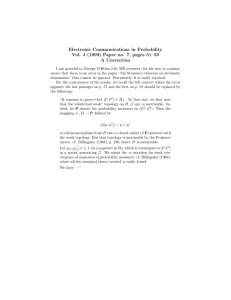
![MA342A (Harmonic Analysis 1) Tutorial sheet 2 [October 22, 2015] Name: Solutions](http://s2.studylib.net/store/data/010415895_1-3c73ea7fb0d03577c3fa0d7592390be4-300x300.png)

